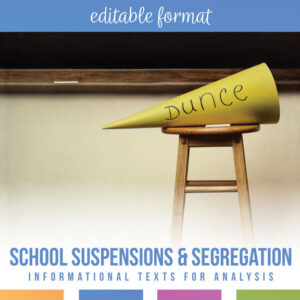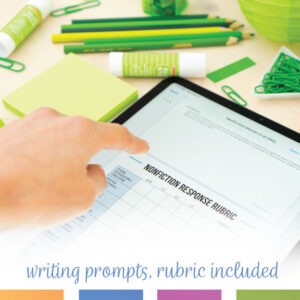Unlocking the Secrets of Argumentative Writing Strategies
Argumentative writing strategies for secondary students can empower young writers.
Secondary language arts teachers will teach argumentative writing. We have concepts, terms, and mentor texts. Argumentative writing strategies should empower as well.
Every student will bring unique approaches to writing and with argumentative topics, opposing viewpoints. The trick as a writing instructor is to wrangle those viewpoints, add critical thinking, and write.
My message with argumentative writing: start small. Provide a mentor text, domain-specific language, and the main points of argumentation, and then write a short response.
Typically, my classes and I respond to a mentor text and implement strategies before moving onto larger writing assignments.
Below is my method.

How can argumentative writing strategies empower students?
Empowering secondary students while teaching the structures of argumentative writing is quite the fine line, almost a dotted line. Presenting the lessons through the lens of empowerment of young writers will cater your messages and consequently make students invested in their writing.
Front-load information.
“Domain-specific language” is in standards for a reason: Students must know the terms and information behind those terms to work within our subject area.
When I introduce writing (of any kind) with my students, I begin with a basic overview of my expectations. For instance, in my argumentative writing presentation, not only do I provide definitions, but I also provide examples to set expectations. In setting students up for success, I share with them my terminology and expectations.
Consider:
- My classes use the term ”topic sentence” for the first sentence in a body paragraph. When I chat with other teachers at conferences, they share different terms.
- Some teachers require a strict topic sentence, a cut and dry explanation for every body paragraph. With older students, especially my dual-credit students, I encourage them to experiment with transitions from the previous paragraph.
- “Signal phrase” is another term in my classroom for introducing research. Again, terminology differs from classroom to classroom.
By explaining and front-loading domain-specific vocabulary, teachers empower young writers in knowing expectations.
What I find helpful is to use the domain-specific language and then remind students of the definitions and then apply the terms to their writing. Most often, mentor texts accomplish this goal.
Remember: start small, emphasize those points, and then move to more difficult concepts.
Provide students with resources.
Simply put, I give students an informational text, we read it, analyze it, and study it, and then students write an argumentative reaction to the piece.
The most successful endeavors involve high-interest informational texts. For instance, teenagers have opinions about our school system, so I give them nonfiction to further educate them. In looking at school suspensions and segregated public schools, the main idea is easy to define, and young writers have enough information for a concise thesis statement.
Those high-interest informational texts provide a base for us to apply terms and identify features. Since writing requires cognitive skills, a small text and our domain-specific vocabulary and concepts in practice allows for students to feel success.
Then, we layer more technical and difficult pieces as the year continues.
Testing the waters of argumentation.
Right away, students and I write to start building a community of writers. We share our ideas and work together to walk through every part of the writing process.
Additionally, I keep a running list of areas that need reinforcements and areas that need praising.
Finally, working with a short mentor text (like the school suspension text pictured above) allows for writers to work with expert opinions and to integrate summaries, paraphrases, and direct quotes. However, if we are testing the waters, they have a concise way to practice, setting them up for longer academic writing and for academic success.
Providing feedback concerning the thesis, paragraph structure, grammar, and more.
As students test out their argumentative chops, I find it a good idea to provide specific feedback with a specific action to take.
In an argumentative essay, the feedback often revolves around the thesis, paragraph structure, and grammar.
Thesis.
The thesis is the writer’s point of view on the subject, sure. In argumentative writing, the thesis must also make a claim for argument writing. Since the thesis guides the paper and comes at the end of the introduction, discuss the impact of those components with young writers.
Once the thesis statement take shape, provide feedback on the introduction to support the thesis.
Paragraph structure.
At one point in my career, I began the year by outlining each type of paragraph. From the introduction (grabbing the reader’s attention) to the concluding paragraph (stressing the claim), I overwhelmed my students.
Beginning the process with a small piece and a shorter writing response allows me to be less rigid about paragraph structure and for students to think outside the five-paragraph essay with a designated counterclaim paragraph.
Grammar.
Grammar in student writing should praise strengths and weaknesses. For instance, writers might struggle with incomplete sentences, vague pronoun use, and punctuation. For others, those areas might be strengths.
Use grammar discussions as an opportunity to guide students through the feedback process. For instance, if students struggle with comma splices, name the struggle specifically and provide support to improve.
Focusing on key elements like the thesis, paragraph structure, and grammar can help them refine their skills gradually. Providing targeted feedback on these aspects not only aids in immediate improvement but also sets a strong foundation for future academic writing endeavors. By honing these fundamental strategies, students can develop clarity, coherence, and persuasive prowess in their argumentative essays.
Explaining the counterargument, the rebuttal.
The counterargument refers to an opposing viewpoint that students should acknowledge and respond to in their argumentative writing. By addressing counterarguments, students can demonstrate a deeper understanding of the topic and strengthen their own argument.
Encourage students to consider different perspectives and anticipate objections from readers. To model, brainstorm ideas together as a class by creating a list of opinions.
Incorporating a rebuttal allows students to refute counterarguments effectively, reinforcing the validity of their own claims. Emphasize the importance of sound reasoning and evidence when crafting rebuttals to further bolster their argument. Refer back to those mentor texts which also have counterarguments.
Final tips about argumentative writing strategies—
I’ve shared before that I teach short stories at the start of the school year. Doing so has advantages like setting the tone and expectations; allowing for student choice; and providing smaller feedback on shorter pieces.
In walking through argumentative writing strategies with shorter pieces, classes receive feedback and experience my methods. The small example of argumentative writing and a short response is similar to responding to a short story and then building toward literary analysis.
Starting small, purposefully using argumentative terms, and giving structured feedback sets up my classes for larger assignments where they will choose their own topics and find their own research.
Hopefully, your students find success too.






